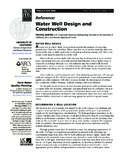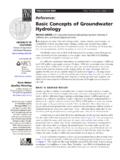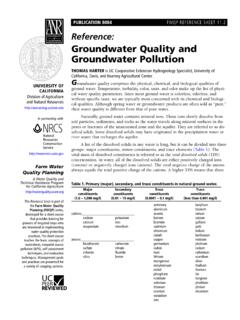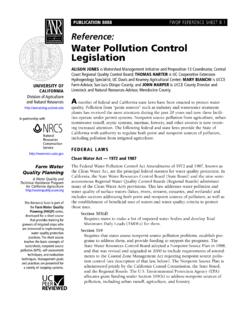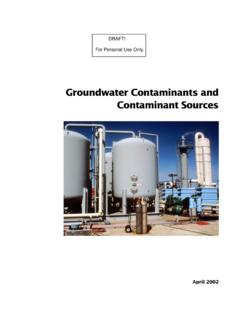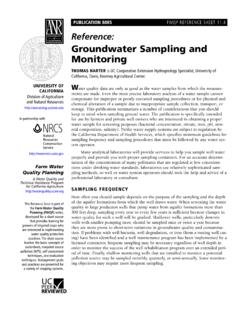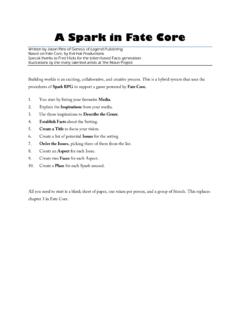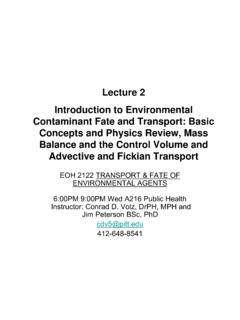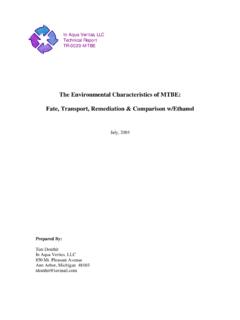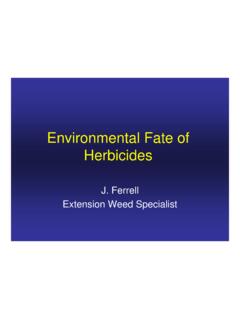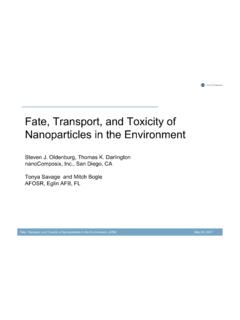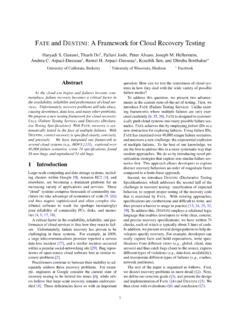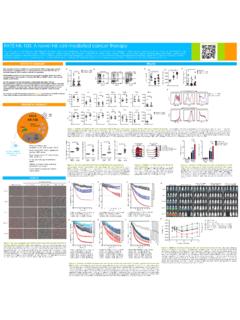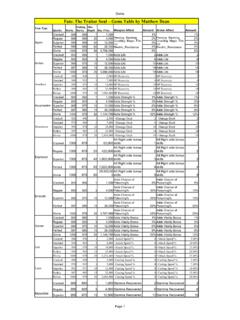Transcription of Transport and Fate of Contaminants in Surface Water
1 Transport and Fate ofContaminants in Surface WaterJune 2001 This booklet is part of a series of educational brochures and slide sets that focuses on various aspects ofwater source protection. The series has been prepared jointly by the University of California AgriculturalExtension Service and the California Department of Health further information about this and other documents in the series, contact the project team leader (seebelow) or visit the following : Rhea Williamson, Department of Civil and Environmental Engineering, San Jose State University, SanJose, Calif.
2 , and John Klamut, Sunnyvale, : Larry Rollins, Davis, crew: Larry Rollins and Pat SuyamaPhoto credit (cover): Larry RollinsCover photo: Merced River, Yosemite National Park, Team leader: Thomas Harter, Department of Land, Air, and Water Resources, University of California atDavisFunding Agency: California Department of Health ServicesThis document is the result of tax-supported government projects and, therefore, is not copyrighted. Re-printed material, mainly figures, is used with permission, and sources are indicated. Statements, findings,conclusions, and recommendations are solely those of the author(s).
3 Reasonable efforts have been made to publish reliable information; however, the author and publishingagencies cannot assume responsibility for the validity of information contained herein, nor for the conse-quences of using such mechanisms exist for thetransformation and Transport ofcontaminants in of a contaminant s chemicalform and of the chemical s ability to besorbed, to precipitate, to dissolve, or tobe degraded is necessary if the fate of thechemical is to be determined in Water exist in two forms: eitheras particulate (filterable) solids or asdissolved (nonfilterable) solids.
4 Withineach group, further differentiation can bemade between organic (volatile) solids andinorganic (nonvolatile, or fixed) amount of a contaminant of concern(COC) found at a given location in theaquatic environment depends on thecontaminant s rate of accumulation. That,in turn, depends on the rates ofcontaminant loading and Transport (Tchobanoglous and Schroeder, 1987). contaminant loading arises from an input (with respect to the Water body)of allochthonous or materials originate fromwithin the watershed, but outside thewater body.
5 A few examples are: erodedsoils and inorganic solids from weatheredrocks, detritus imported from thecatchment basin ( , leaves, twigs,grasses), fecal material, and organic andinorganic pollutants from road material originates fromwithin the Water body. It includesungrazed plant components such as cellsand tissues, undigested plant materialswithin animal feces, and dissolvedsubstances released by phytoplankton,macrophytes, and animals (Cole, 1994). Allochthonousloadings are usually less organic than autochthonousloadings (Chapra, 1997).
6 Once a material is present in a Surface body of Water , itcan be transported within the Water body, volatilizedor transported into the atmosphere, sorbed into thesoil or solid matter in the Water , precipitated or dissolvedinto and out of the Water , degraded by photolysis, ortransformed by to AirMany different contaminant Transport processes occurin a Water body at the boundary between Water and mechanisms include wind, hydraulic turbulence,and gas and hydraulic turbulence represent the transferof airborne Contaminants into Water by mechanicalmeans.
7 Gas transfer is controlled by the difference inconcentration of a gas in Water and air. If theconcentration of a gas in the atmosphere is greater thanthe concentration of that same gas in Water , then thegas will tend to be absorbed into the Water . The reverseis true, too: if the gas exists in the atmosphere at lowerconcentration than in Water , it will tend to come out ofsolution. However, a gas film and Water film in betweenthe Water body and atmosphere can limit the effect ofthe concentration gradient in gas transfer. Figure 1shows absorption of a gas into a liquid, and desorptionFigure 1: Gas transfer from Water to air (and vice versa): (a ) absorptionand (b) desorption (Peavy et al.)
8 , 1985).2of a gas out of a liquid, resulting from a concentrationgradient across a gas film and liquid to WaterWithin the Water body itself, the possible modes oftransport include advection and diffusion (Figure 2).Advection occurs when a COC moves as a result offluid motion but the contaminant s concentrationremains unchanged. Chapra (1997) defines advectionas a flow that is unidirectional and does not change theidentity of the substance being transported. Basicexamples of advection are the downstream transportof a contaminant (1) in a river or (2) through a occurs when a COC is transported along aconcentration gradient from a region of highconcentration toward a region of lower concentration(Tchobanoglous and Schroeder, 1987).
9 Diffusivetransport occurs because of random mixing or motionsin the Water . Diffusion can be modeled by using Fick sFirst Law:Jx = D(dc/dx)where:Jx= mass flux in the x directionD = the diffusion coefficientdc/dx= the concentration gradientFick s First Law shows that the mass flux is proportionalto the rate of change of the concentration of thecontaminant. The diffusion coefficient is used toquantify the rate of the diffusive process. Therefore, iflittle or no mixing or turbulence occurs in a Water body,the diffusion coefficient would be low. On the otherhand, if mechanical mixers are present in a Water body,then the diffusion coefficient would be high (Chapra,1997).
10 Dispersion is a third possible mode oftransport within a Water is related to diffusion in thatit will mix a contaminant in a waterbody. However, whereas diffusionmixes Contaminants in Water due torandom motions in the Water over time( , wind, waves, turbulance),dispersion mixes Contaminants in waterdue to velocity differences in a givenspace (Chapra, 1997).Figure 3 shows an example ofdispersion in a pipe. The velocity nearthe walls of the pipe are less than thevelocities in the center of the pipe. Thedifference in these velocities results ina gradual mixing of the Water alongthe axis of the pipe.
